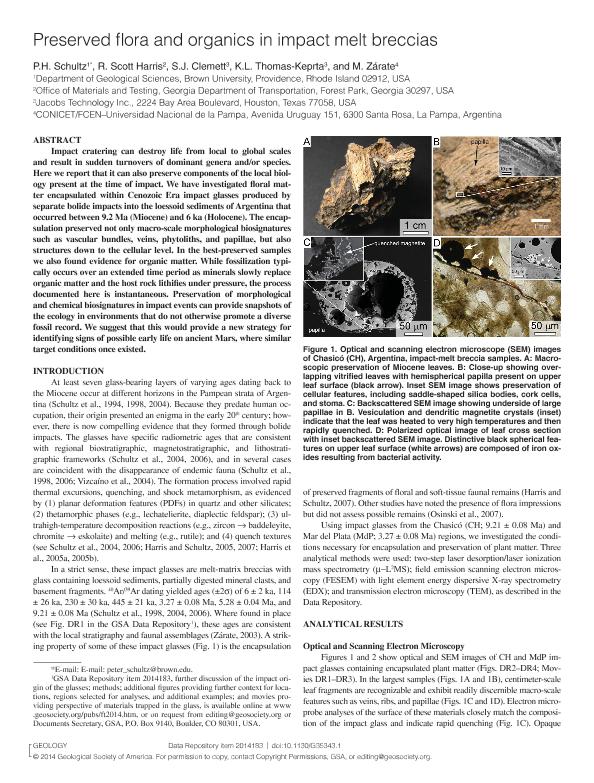Mostrar el registro sencillo del ítem
dc.contributor.author
Schultz, P. H.
dc.contributor.author
Harris, R. Scott
dc.contributor.author
Clemett, S. J.
dc.contributor.author
Thomas Keprta, K. L.
dc.contributor.author
Zárate, Marcelo Arístides

dc.date.available
2017-06-30T21:53:09Z
dc.date.issued
2014-06
dc.identifier.citation
Schultz, P. H.; Harris, R. Scott; Clemett, S. J. ; Thomas Keprta, K. L. ; Zárate, Marcelo Arístides; Preserved flora and organics in impact melt breccias; Geological Society of America; Geology; 42; 6; 6-2014; 515-518
dc.identifier.issn
0091-7613
dc.identifier.uri
http://hdl.handle.net/11336/19360
dc.description.abstract
Impact cratering can destroy life from local to global scales and result in sudden turnovers of dominant genera and/or species. Here we report that it can also preserve components of the local biology present at the time of impact. We have investigated floral matter encapsulated within Cenozoic Era impact glasses produced by separate bolide impacts into the loessoid sediments of Argentina that occurred between 9.2 Ma (Miocene) and 6 ka (Holocene). The encapsulation preserved not only macro-scale morphological biosignatures such as vascular bundles, veins, phytoliths, and papillae, but also structures down to the cellular level. In the best-preserved samples we also found evidence for organic matter. While fossilization typically occurs over an extended time period as minerals slowly replace organic matter and the host rock lithifies under pressure, the process documented here is instantaneous. Preservation of morphological and chemical biosignatures in impact events can provide snapshots of the ecology in environments that do not otherwise promote a diverse fossil record. We suggest that this would provide a new strategy for identifying signs of possible early life on ancient Mars, where similar target conditions once existed.
dc.format
application/pdf
dc.language.iso
eng
dc.publisher
Geological Society of America

dc.rights
info:eu-repo/semantics/openAccess
dc.rights.uri
https://creativecommons.org/licenses/by-nc-sa/2.5/ar/
dc.subject
Impact Glasses
dc.subject
Organic Remains
dc.subject
Pampean Loess
dc.subject
Argentina
dc.subject.classification
Geociencias multidisciplinaria

dc.subject.classification
Ciencias de la Tierra y relacionadas con el Medio Ambiente

dc.subject.classification
CIENCIAS NATURALES Y EXACTAS

dc.title
Preserved flora and organics in impact melt breccias
dc.type
info:eu-repo/semantics/article
dc.type
info:ar-repo/semantics/artículo
dc.type
info:eu-repo/semantics/publishedVersion
dc.date.updated
2017-06-29T13:58:02Z
dc.identifier.eissn
1943-2682
dc.journal.volume
42
dc.journal.number
6
dc.journal.pagination
515-518
dc.journal.pais
Estados Unidos

dc.journal.ciudad
Boulder
dc.description.fil
Fil: Schultz, P. H.. University Brown; Estados Unidos
dc.description.fil
Fil: Harris, R. Scott. Georgia Department of Transportation. Office of Materials and Testing; Estados Unidos
dc.description.fil
Fil: Clemett, S. J.. Jacobs Technology Inc.; Estados Unidos
dc.description.fil
Fil: Thomas Keprta, K. L.. Jacobs Technology Inc.; Estados Unidos
dc.description.fil
Fil: Zárate, Marcelo Arístides. Consejo Nacional de Investigaciones Científicas y Técnicas; Argentina. Universidad Nacional de La Pampa; Argentina
dc.journal.title
Geology

dc.relation.alternativeid
info:eu-repo/semantics/altIdentifier/url/https://pubs.geoscienceworld.org/geology/article-abstract/42/6/515/131574/preserved-flora-and-organics-in-impact-melt?redirectedFrom=fulltext
dc.relation.alternativeid
info:eu-repo/semantics/altIdentifier/doi/http://dx.doi.org/10.1130/G35343.1
Archivos asociados
